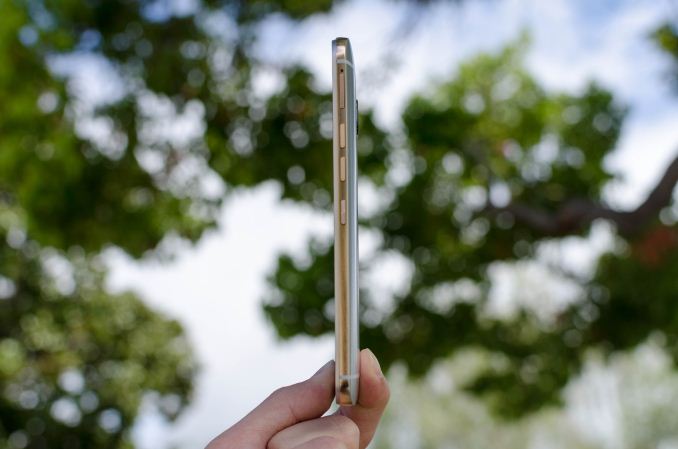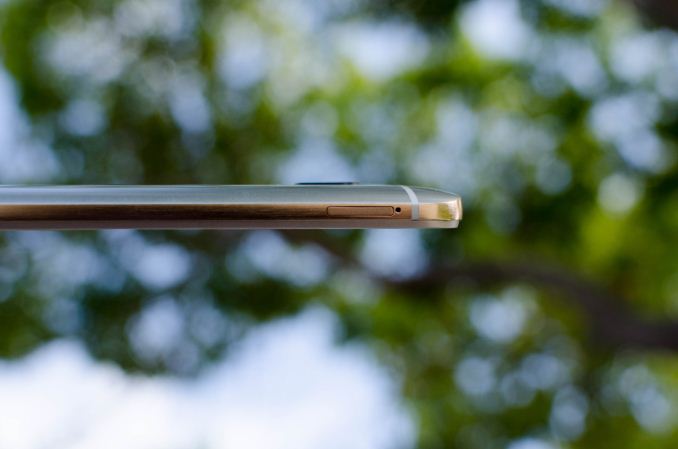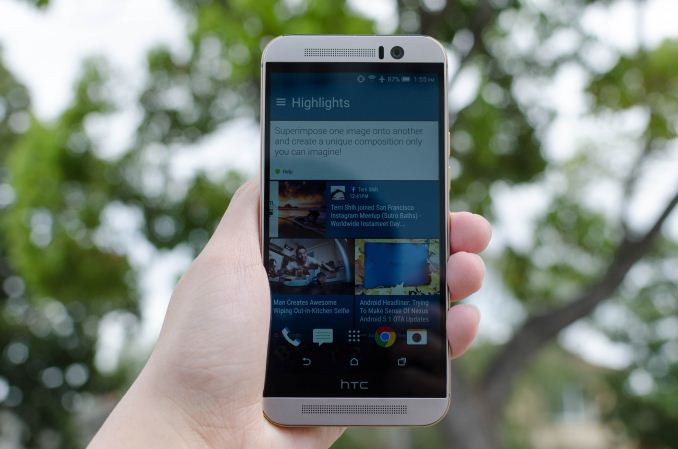The HTC One M9 Review: Part 2
by Joshua Ho on April 6, 2015 10:00 AM EST- Posted in
- Smartphones
- HTC
- Qualcomm
- Mobile
- Snapdragon 810
- One M9
Final Words
Now that we finally have all of the pieces together, we can come to some proper conclusions about the HTC One M9. For those that haven’t read part one of this review, it’s really necessary to do so to understand the context in which these comments are made.
There’s a lot to talk about here, so we’ll start with the design of the phone. HTC is probably the company best-known for design in the Android space, and with the One M9 it seems that they hope to capitalize on this by electing not to significantly change the design.
However, there are a few key changes to the One M9’s design when comparing it to the One M8. For instance, the One M9 moves the power button to the right side of the phone, changes the finish of the back cover, squares off the back cover, and replaces the front plastic bezel with a new plastic bezel. All of these changes seem to make some sort of sense at first, but they almost feel like a regression in some ways. The power button is on the side, but it takes a lot of effort to press it when the phone is held normally in the hand. However, it’s conveniently placed to accidentally press when picking the phone up from a table.
Meanwhile the back cover has a new finish and a neat dual-anodized color, but I question the value of these changes when they reduce yield and drive cost up, especially when sand-blasted anodized aluminum is comparable in look and feel. The continued use of the plastic bezel on the front also cheapens the feel of the phone. The new hard edges on the back cover is also quite uncomfortable, especially when compared to the M8’s smoother curve. There is also the issue of the “logo bar” bezel, but it’s physically impossible to get rid of this bezel due to engineering constraints.
The next aspect worth examining is the display. To HTC’s credit, a 1080p display at 5 inches is the right tradeoff to make with an RGB-stripe display. However, it’s concerning to see significant regressions in almost every area when comparing the display to the M8. An amazing display is almost a requirement for flagship smartphones at this point, and to see such a poor display with equally poor calibration is disappointing. It was clear in the past that HTC genuinely cared about delivering an amazing display, but somewhere along the way it seems that they forgot. We can speculate about the reasons behind this, but this is something that HTC has to fix if they want to remain relevant in the smartphone space, just like every other OEM at this point.
The other critical point of a smartphone is its ability to remain mobile. Battery life is probably the most important aspect of any smartphone, and a poor showing here can be enough to write off a phone. HTC has traditionally done quite well here despite using a smaller battery in their phones than average. Unfortunately, this isn’t true of the One M9. Despite using a newer SoC and a bigger battery, HTC regresses significantly in battery life when compared to the One M8. Although it seems that MIPI command mode has been removed from the One M9, it’s likely that most of the increased power draw can be directly attributed to the SoC, as the impact of panel self-refresh is relatively small.
Speaking of the SoC, the Snapdragon 810’s performance does generally provide a decent improvement over the Snapdragon 805, but it’s relatively little due to HTC’s governor settings which make it quite difficult to reach the maximum 2 GHz state. GPU performance is better than what we see on the Galaxy S6, but this is due to HTC’s choice to stay at a lower native resolution. At the same resolution, the Exynos 7420’s Mali T760 GPU is faster due to higher clock speeds. It’s also disappointing that HTC continues to use benchmark optimizations. The difference in performance is so small at this point that HTC should seriously consider removing these optimizations altogether, as it isn’t worth getting delisted from multiple benchmarks.
The camera of the One M9 is also a weak point, despite significant changes on HTC’s part in this area. Unfortunately, the post-processing here is just not acceptable, and the results of the camera are equally unacceptable. We will have to see how the camera performs without HTC’s heavy-handed post-processing when they update the camera to shoot in RAW, but HTC needs to improve dramatically here for next year.
The one positive note here is Sense 7, which continues to be one of the best experiences in Android overall. I fundamentally disagree with the assertion that a user should go to the Play Store to find various applications that they like, as taking this to its logical conclusion basically ends with having to download a dialer application from the Play Store on first boot. Blinkfeed continues to be a solid application for news, social media, and other information, and HTC’s apps in general are a strong point of differentiation judging by the demand from users to port them to non-HTC phones. However, I still think that HTC didn’t do enough for this iteration of Sense. Most of the applications still feel like they mesh best with Android 4.4, and overall the UI needs to be redesigned to fit with Material Design.
Overall, further testing of the One M9 basically confirms my fears, which were that the One M9 is effectively a sidegrade of the One M8 at best. I really did want to like this phone, as I still find the One M7 to be a great phone to use. I really wanted to see a phone from HTC that was worthy of an upgrade from the One M7, but the One M9 isn’t that phone. In fact, given that the One M8 is at least 200 dollars cheaper than the One M9 on contract, I find it incredibly difficult to recommend the One M9. It will definitely have its fans, but overall there are more negatives than positives. Given the competitive positioning of the One M9, the timing of the Snapdragon 810, and the strength of the Galaxy S6 I’m faced with an intense sense of déjà vu. It almost feels like we’re back where we started 3 years ago with the Sensation and Galaxy S2. I can't think of a better way to describe the situation HTC is in, which is alarming to say the least. The One M9 can't be another Sensation, but it feels like it is.














127 Comments
View All Comments
nismotigerwvu - Monday, April 6, 2015 - link
This is quite sad really. Both the HTC devices I've owned (going way back for the 1st with a Windows Mobile 6 packing Mogul/Titan and more recently the OG Evo) have been fantastic pieces of hardware. Perhaps some continued firmware tweaks can bring the camera performance back around, but the SoC really seems to be dragging the model down. Maybe even a midcycle refresh, like and M8+ with a better suited SoC. I haven't looked into it in awhile, but at least a few months ago there were rumors floating around of a new model that massaged the power usage a bit, I think it was being referred to as an 815 but this is purely off memory.DanNeely - Monday, April 6, 2015 - link
Qualcomm is denying that there was ever such a thing as an 815 on their roadmap; and is putting the 820 on the roadmap for retail availability at the end of this/start of next year.http://www.fudzilla.com/news/mobile/37406-there-is...
Laxaa - Monday, April 6, 2015 - link
I really wonder how the rest of this years Snapdragon 810 devices will perform. The LG G4 is even rumored to be using the 808 instead, due to the issues with the G Flex 2.jjj - Monday, April 6, 2015 - link
It's all good, Qualcomm will provide free cases with 60mm USB powered fans for every phone with Snapdragon810.As an alternative they'll also sell phase-change cooling backpacks.
Frenetic Pony - Monday, April 6, 2015 - link
A large part is the Cortex a57 and a53 cores. By all the looks of it Qualcomm could, and should, have stuck with their increasingly aging Snapdragon cores, shrunk the process to TSMC or Samsung's 20nm, and gottent better perf/battery life out it.blanarahul - Monday, April 6, 2015 - link
While it is true that the S810 would have been better with Krait, you have to consider the fact that ARM had already optimized the A57 and A53 cores for 20 nm and Qualcomm would have had to spend additional resources to get Krait to work well on 20 nm which would:-a) Ended up delaying Krait's ARMv8 successor.
b) Not be as efficient because a lot of improvements in Krait 400/300 came from the fact that 28 nm was a mature process and Qualcomm was used to it.
blanarahul - Monday, April 6, 2015 - link
You have to blame HTC to really. They should have compensated for S810 by including panel self refresh and a bigger battery but noooo, they want to make the phone as cheap as possible (display isn't well calibrated remember) and sell well for 700$. Sorry HTC, you aren't getting much money this year.Gunbuster - Tuesday, April 7, 2015 - link
but but but R&D costs money, blah blah blah...Nope they slap the same commodity SOC, screen, battery, and camera together just like everyone else these days. The $600+ phone gravy train is running off the tracks.
skavi - Wednesday, April 8, 2015 - link
They did add a larger battery.TylerGrunter - Tuesday, April 7, 2015 - link
The Krait cores were only competitive against A15 cores due to their ability to run at higher frequency. The issue with that is that 20nm in TSM they only had LPE, which seems to be terrible at high frequency, so they needed to use cores with higher IPC or there would be a huge performance regression and a terrible comparison with A57 cores.